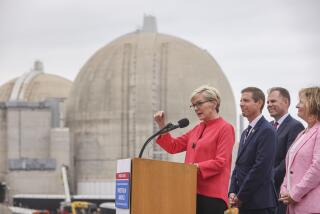Intel to Build Computer to Track Nation’s Nuclear Bombs
- Share via
WASHINGTON — The Energy Department announced Thursday that it will work with Intel Corp. to develop a powerful new computer that will help make it possible to assure the safety and reliability of the nation’s nuclear weapons stockpiles without setting off underground nuclear explosions.
The $45-million project, which by the end of 1996 will create a computer 10 times faster than anything that exists today, also represents a renewed government commitment to a supercomputer policy tarred last year when Thinking Machines, a high profile, government-backed supercomputer company, filed for bankruptcy.
“This agreement marks the advent of a new era in high performance computing that will significantly benefit our national security,” Energy Secretary Hazel R. O’Leary said.
President Clinton announced a moratorium on nuclear tests in 1992 and recently announced he would push for a global ban on nuclear weapons testing. The problem facing the Energy Department is how to ensure the reliability and safety of about 6,000 to 7,000 nuclear bombs that constitute the nation’s permanent nuclear stockpile without any periodic testing of the bombs.
Weapons scientists compare the problem to assuring the airworthiness of a Boeing 747 jetliner after it has been parked for 20 to 30 years--without actually flying it.
The Energy Department plans to spend about $40 billion in the next decade to assure the integrity of the nuclear stockpile. The new computer will be crucial to this effort because it will allow scientists to build better computation models to simulate nuclear donations, said Assistant Energy Secretary Victor Reese.
Without the crash effort to develop a powerful new computer, the shortfall in computation capability would ultimately erode confidence in the nuclear stockpile to a point that would be “unacceptably low,” Reese said in an telephone interview.
A nuclear warhead contains about 50 pounds of high explosives wrapped around a hollow plutonium sphere. As the assembly ages, the plastic explosives undergo chemical changes and the plutonium sphere can corrode or crack. The computers will allow bomb scientists to examine how a bump or a crack will affect the detonation, Reese said.
The new computer will cover 1,500 square feet of floor space in the Energy Department’s Sandia National Laboratory in Albuquerque, N.M., and will be made up of 9,000 of Intel’s next-generation microprocessors, the P6. Using many off-the-shelf, personal computer-type microprocessors operating in parallel has in the past several years become the preferred technique for achieving extremely high computing speeds--1.8 trillion mathematical calculations a second, in the case of this new machine.
Intel beat out a field that is believed to include IBM Corp., Cray Research Inc. and Silicon Graphics Inc.
The broader market for these “extreme scale” computers would be limited. “One could make the case that the French ought to buy one,” said Intel Vice President Ed Masi, referring to protests over French underground nuclear tests in the South Pacific.
But the computer will be the first in a new generation of machines that will help scientists tackle a new range of problems by better representing reality in computer code. For example, scientists say such computers will lead to more accurate weather forecasts. Aircraft manufacturers could use them to design airplane cockpits to block electromagnetic interference from laptops and other gadgets being used by passengers in the cabin.
The new computer project also helps reaffirm the strategic role of a high-performance computer sector that was undermined when Thinking Machines, which pioneered the processing of the type now being used by Intel, filed for bankruptcy last year. Some industry observers suggested then that industry and government should concentrate on low-cost computers and questioned the need for more and more powerful machines.
“This punctuates the point that there are no shortage of problems for both high end computers and personal computers,” says Sid Karin, director of the San Diego Supercomputing Center of Energy Department program.
More to Read
Sign up for Essential California
The most important California stories and recommendations in your inbox every morning.
You may occasionally receive promotional content from the Los Angeles Times.














